I will make it a point to follow your page on a consistent basis in order to access any fresh and fascinating information. In tap road, the sole aim you have to do is to direct a ball as it rolls at an ever-increasing speed.
Capital Audiofest 2024 Show Report
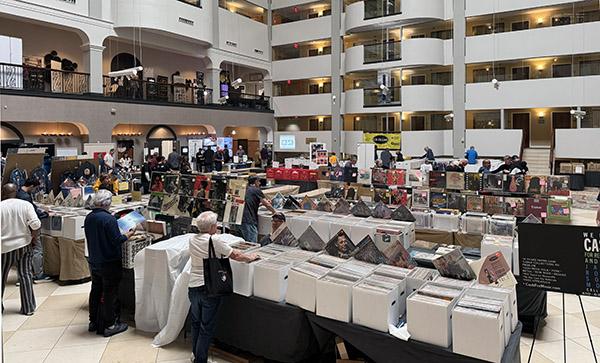
SVS
SVS went in a different direction at this show. Instead of their usual immersive surround sound exhibit, this time they focused on capturing the attention of the two-channel crowd. They conducted an A/B demo between the Ultra Evolution Bookshelves ($599 each), paired with the new PB17-Ultra R|Evolution subwoofer ($2,999), and the Ultra Evolution Pinnacle towers ($2,499 each).
This revealed just how good the towers are. Using Qobuz streamed from a tablet into the Hegel H400 Streaming Integrated Amplifier ($6995), and starting off with Bob Dylan's Man in the Long Black Coat, I found that the towers possess just a tad more detail than the bookshelves and are fully capable in the bass region—speakers that truly do not need subwoofer augmentation.
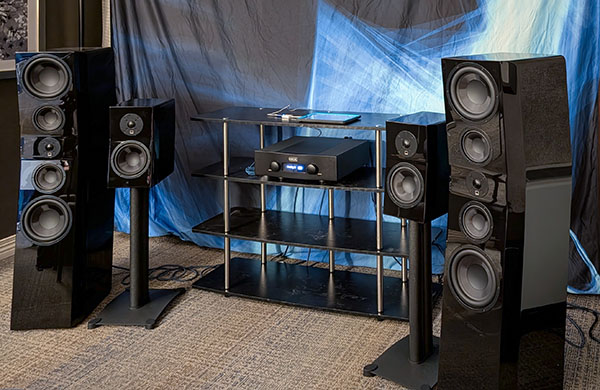
Continuing with the A/B comparison, YOOKiE's SUNSHiNE OF YOUR WUB just slayed on the Evolution towers—mids, highs, and lows—while, conversely, Miles Davis's Someday My Prince Will Come (feat. John Coltrane, Hank Mobley, Wynton Kelly, Paul Chambers, & Jimmy Cobb) delivered the relaxed sound we expect from that track. Of note is the trumpet, used by SVS to show off how well the diamond-coated tweeter handles Miles's demanding playing.
Playing the Evolution Bookshelf sans subwoofer, Honky Tonk Woman by The Rolling Stones demonstrated just how low the 6.5" drivers can go, seeming to dig a bit deeper than the 40Hz specification would imply.
I did not get to hear the new PB17-Ultra R stretch its legs; it was dialed back to match the monitors, and a lesser sub, say the SVS SB-2000 Pro ($699), would have done just fine in this scenario. I do look forward to the next SVS audio/video show exhibit and hope the PB17-Ultra R (or two) is part of it. Overall, the towers bested the bookshelf/sub combo, but the smaller system did give a good account of itself and, when paired with the aforementioned SB-2000 Pro, would be $3,700 less than the towers. Either way, SVS has knocked it out of the park with the latest Ultra Evolution line.
The DC HiFi Room
The DC HiFi room showcased the new Radiant Acoustics Clarity 6.2 loudspeaker ($4,500), which uses PURIFI USHINDI woofers and an AMT tweeter designed by DALI Speakers. An Apple computer streamed content to a TEAC UD-507 USB DAC/preamp ($2,099.), which fed a VTV amplifier with the latest Purifi 1ET6525SA amplifier modules (price unknown), powering the Clarity 6.2 speakers.

Vocals on Steven Wilson's Pariah (feat. Ninet Tayeb) were nicely placed, far behind the boundaries of the front baffles, a quality that carried over in Shekere by Vince Mendoza, an effect that brought instruments forward in the mix. Yellowjackets' Man Facing North starts off with piano and drums, both percussive instruments brought forth with great detail and dynamics. Crisp and clean, and surprisingly loud, this all-Purifi power and drivetrain system was of high caliber.
The Vinyl Revivers/Audio Hunters/Linkwitz Audio
The Vinyl Revivers/Audio Hunters/Linkwitz Audio room featured another very simple system, consisting of a CD player, a turntable, and two combination crossovers/5-channel amplifiers supporting the Linkwitz LX521.4MG dipoles, with 100 watts for the tweeter, 2 x 125 watts for the upper and lower mids, and 2 x 250 watts for the dual woofers.
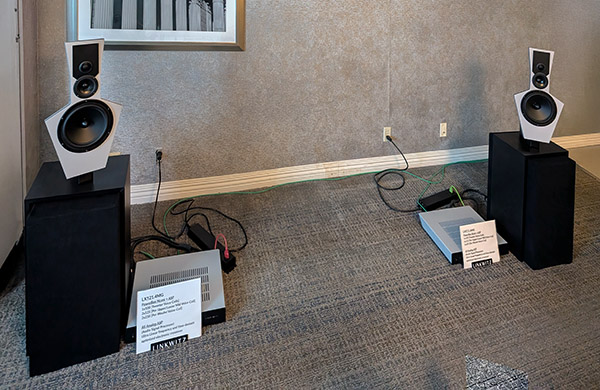
Once again, I was unable to get into the money seat, even after waiting a half hour for it. I hope the guy who sat there all that time bought something! Still, I was able to capture a good dose of that dipole magic, starting off with the digital source playing Brendan Perry's Voyage of Bran. The soundfield was spacious, the track haunting, with ghost-like voices and instruments suspended in air like few speakers can do. I’ve heard many Linkwitz designs, and this characteristic is their calling card.
Switching to an analog source, I Robot by The Alan Parsons Project demonstrated—or rather, the LX521.4MG demonstrated—the difference in presentation between the two tracks and media sources. The soundstage collapsed a bit, slightly smaller with tighter spaces between the images. Still, that Linkwitz quality of suspended, ghost-like images held true, just on a smaller scale, with the contrast drawn sharply by the Linkwitz LX521.4MG system.
Audeze
At the Audeze booth, I had the chance to hear their latest flagship, the CRBN2 Electrostatic Headphones ($5,995, projected availability early December). A tablet streaming Qobuz into a Bricasti Design M1 Series II DAC ($12,500) provided input for an iFi Audio iCAN Phantom ($3,749), creating a truly state-of-the-art signal chain.

When I fired up the now-familiar Ghost Rider – Make Us Stronger track, it provided one of the most exciting listening sessions at the show. This song demands "quickness" out of a system, and the demand was fully met, with no overhang on any part of the frequency spectrum, generating an enveloping soundfield with a driving beat, spacious electronica, and a big soundstage that extended beyond the ear cups, with specific image placements on that stage.
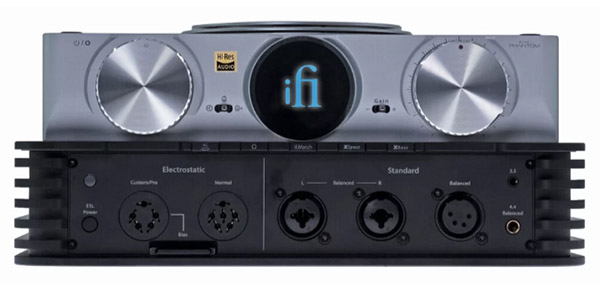
The show was winding down, and I had time for one more song. I chose Metallica's One to test the CRBN2's capabilities with metal music. The intro gunfire and explosions were far off in the distance—farther away and at a lower volume than I’ve ever experienced on any system with loudspeakers or headphones.
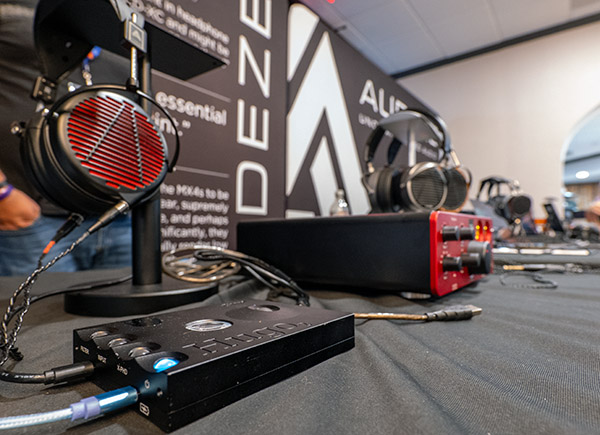
The solo rhythm guitar, then the lead guitar, began to play, with the lead vocals picking up steam as the song crescendos into its first chorus. The CRBN2 and its accompanying electronics showed me that the soundstage was more compressed than the Ghost Rider track. At no point or reasonable volume level did the stage compress into an unusable mess; the system held this admittedly rough mix/master together, encouraging me to press harder on the iFi amplifier.
The Listening Room
The Listening Room, based in Chestertown, Maryland, featured two different systems: a 2.1 stereo setup and a 5.1.4 Atmos system, supported by Casaplex in Kensington, Maryland.
The 2.1 system showcased an upcoming Magnepan model, the MCR. The system used a 40" ribbon, the same one as in the 2.7i, fed by a Primare I15 and a small REL subwoofer. Firing up the new, ubiquitous show exhibitor track Ghost Rider – Make Us Stronger (to be fair, I requested that), I was treated to a much bigger soundstage than I expected. Later, I returned with my partner, who is accustomed to listening, in our home, to a much larger pair of subwoofer-supported Magnepan 1.7i (purchased from The Listening Room). She involuntarily expressed her surprise at the outsized presentation produced by the comparatively diminutive MCR.
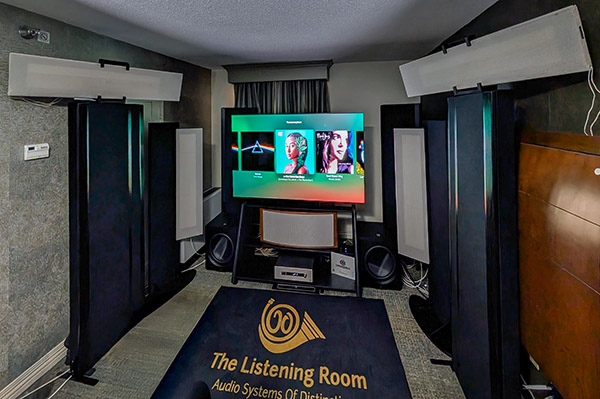
As enjoyable as the 2.1 system was, the real treat—and the talk of the Capital Audiofest crowd—was the Atmos system. The MCR, along with the curved ribbon and planar CCR center, provided the bed layer, while the immersive Atmos height was handled by four MC-1 speakers. Two Perlisten R15 subwoofers took care of the LFE channel, and a Primare SPA25 integrated amplifier managed signal processing and amplification duties. Casaplex contributed an LG OLED 77C2PUA panel, a legacy Kaleidescape Strato S 6TB player, and looping movie playlists with custom scene selections for demo purposes.
First up was Sting: Live at the Olympia Paris, providing multiple showgoers in the mini-theater room with an excellent soundstage and imaging portrayal that transported us from the room into the concert venue. We found ourselves front stage, with all the requisite audience noises coming from the appropriate places—sides and surrounds—with immersion made complete by the MC-1 height speakers. The dispersion pattern of the dipoles is limited vertically, so these height speakers were placed on their side to optimize the pattern.
Next was Top Gun: Maverick "Test Run" scene, which demonstrated the system's surprising dynamic capabilities—a testament to the power of the Primare SPA25 integrated amplifier. It’s a dramatic scene that showcases just how violent flying a jet fighter can be, with the Magnepan/Perlisten/Kaleidescape/LG combination fully engaging participants in the excitement of the moment.
GTT Audio
The GTT Audio room featured the Vivid Audio Giya G3s2 ($47,800), supported by the Master Fidelity NADAC C&D ($50,500), TLA TSI-Signature Integrated Amplifier ($53,700), Auralic Audio Aries G2.2 Streamer ($6,100), Dejitter It Switch X ($3,500), Dejitter It WiFi X ($850), and various Kubala Sosna Elation! cables ($27,750). Of particular interest to me, and most likely to those reading along, were the 4-way, 5-driver Vivid loudspeakers.
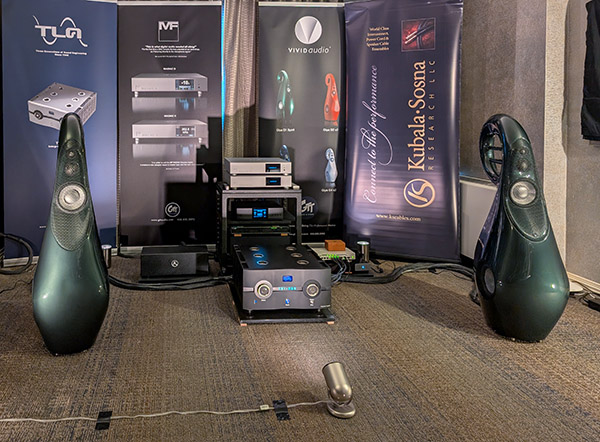
Unable to get the money seat, I sat just left of center. While playing Yuko Mabuchi Trio's What Is This Thing Called Love? (Live), the weight of the bass was surprisingly subterranean—not just heard, but felt as well. I did not expect that from a speaker of this size! The percussion instruments in the Helge Lien Trio's Take Five had impactful dynamics. The bass carried that same amazing weight as before, and the piano tonality was nearly spot-on. Any slight deviation from perfect piano tonality was most certainly attributable to the room acoustics or the recording itself. I could hear the sidewall reflections causing just a bit of smearing, making a good case for acoustic treatments in exhibitor rooms. Still, I could hear the innate pedigree and decades of baked-in experience that come from the former B&W engineer, Laurence Dickie, and found the Giya G3s2 to be near the top of the heap. The company's reputation is well-earned. The supporting electronics stepped aside, passing the music along to the speakers unhindered.
JansZen Audio
The JansZen Audio room featured the simplest system imaginable: the Valentina A8-SE Active Electrostatic Hybrid Loudspeakers ($14,349). Needing only a source, the Valentina is self-contained, and tunes were streamed from a smartphone using aptX Bluetooth. Capable of 35Hz–20kHz in medium to large rooms, with 30Hz possible in smaller rooms, and 116dB transient peaks at a distance of 8 feet, this small speaker is quite heroic for its size.
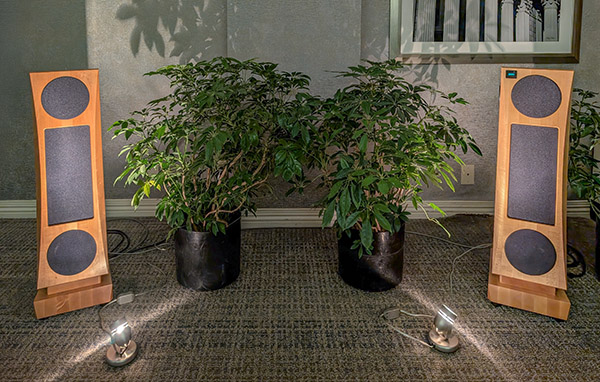
Two sealed 8" woofers cross over 2nd order at 500Hz to a 7"x16" electrostatic panel, with three NCORE amplifiers—one for the woofers, one for the electrostat, and one for the three side and rear full-range omni drivers (more on these later)—for a total of 1100 watts per speaker. There are five inputs: Analog RCA, balanced XLR, Digital AES (balanced XLR), Optical S/PDIF (TOSLINK), and Coax RCA S/PDIF. Weighing 62 lb, the A8-SE is 36" high, 10.2" wide, and 8.9" deep.
Built unlike any other speaker I’ve seen, the A8-SE has another unique attribute: the ability to change its dispersion characteristics from Directive to Omni via the included remote control and the aforementioned side and rear full-range drivers. Using two different Omni programs—Moderate or Substantial—"Stereo Everywhere" is the effect JansZen is going for, and it most certainly works. I bounced around the room to three other chairs besides the sweet spot, and the imaging remained anchored between the speakers. Listening to Gerald Moore & Jacqueline du Pré's Élégie in C Minor, Op. 24 (1995 Remaster), David Janszen toggled between Omni and Directive to demonstrate the effect.
Back in the sweet spot, I experienced an almost headphone-like experience, with the images confined narrowly between the speakers. Bouncing around to various seats again, the effect was just as expected: the images shifted, favoring the speaker I sat closest to. Switching to Omni, "Stereo Everywhere" delivered on its promise, filling in the center and making it sound almost as good as the sweet spot seat, no matter where I sat.
JansZen Audio has been around since the 1950s, and it’s good to see this seminal hi-fi company still chugging along and breaking new ground in the high-end audio world.
Vinyl Sound USA
The Vinyl Sound USA room brought a bit of an anomaly to the show: a point-source speaker, the Tannoy Stirling III LZ Limited Edition ($12,500/pair), with the addition of a super tweeter, the Tannoy Prestige SuperTweeter ($4,390/pair). The HiFi Rose RS150B Reference Network Streamer ($4,995) supplied the digits, and an Accuphase E-800 Integrated Amplifier ($19,975) provided the power.
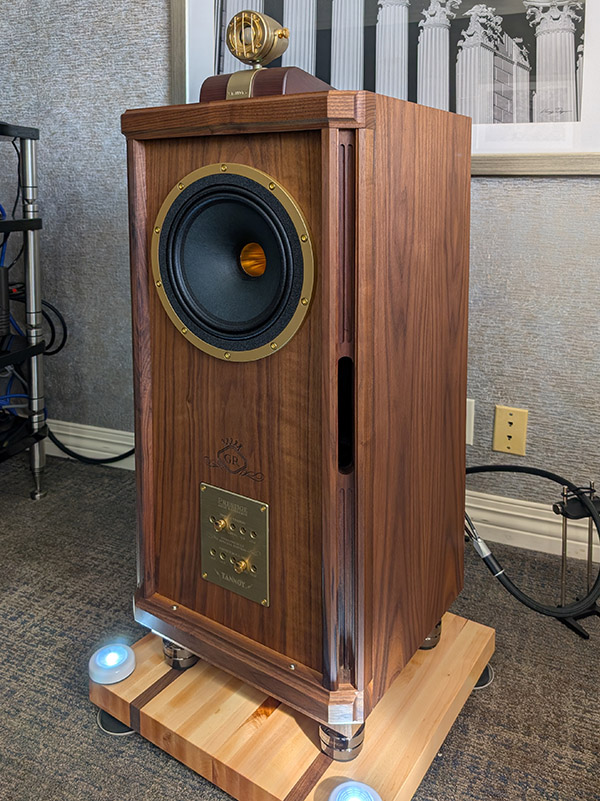
I did not intend to write up this room, as adding a super tweeter to a point-source speaker is something I would normally frown upon, since we no longer have a pure point-source speaker. However, the sound I heard with this combination kept me pinned to the listening chair. Diana Krall's They Can't Take That Away from Me had superb front-to-back layering, with the bass and piano accompaniment playing just a few feet behind Ms. Krall.
I was surprised by the super tweeters; they are not something I would typically use. Their chosen crossover point was a lofty 16kHz. Listening to George Benson's Rainy Night in Georgia further demonstrated their usefulness, with the same exemplary front-to-back layering as before. Adding such tweeters to a point-source concentric is definitely an oddity, but it worked very well. The delivery was soft and smooth, with zero harshness or brightness that one might expect from such a setup.
- Log in or register to post comments


Audize are the headphones ! Crazy what they are capable for.
Robert from Toiture Rive-Nord, A family business.

Beyond the main levels, Geometry Dash Lite offers endless possibilities with its level editor, allowing players to create and share their own challenging stages.

I appreciate the author for such useful content. Here are some sites that I think are good and I want to share them.schedule 1 game:From small-time dope pusher to kingpin - manufacture and distribute a range of drugs throughout the grungy city of Hyland Point. Expand your empire with properties, businesses, employees and more.














































